2015 MERCEDES-BENZ SLS AMG GT COUPE brake pads
[x] Cancel search: brake padsPage 120 of 290
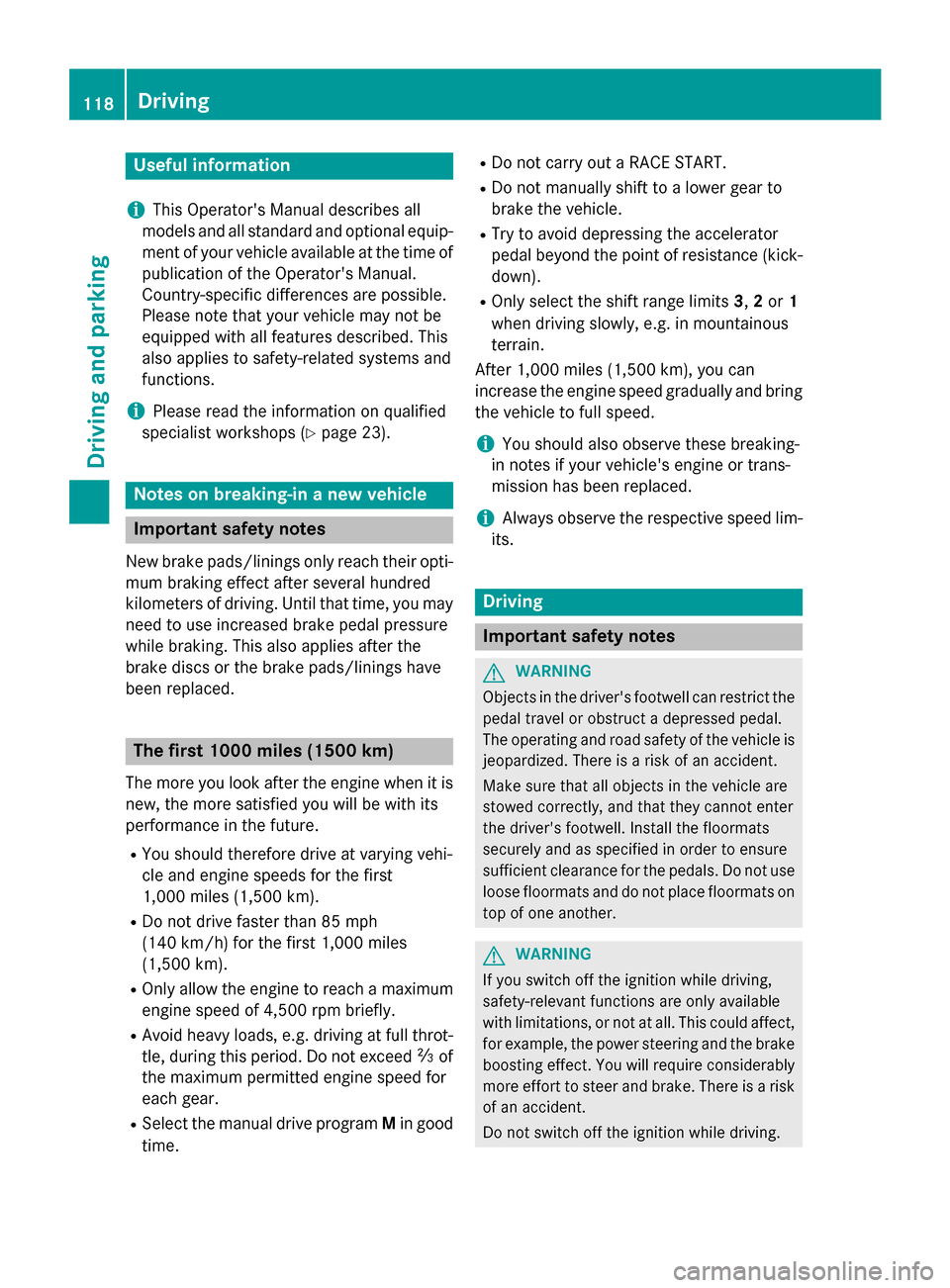
Useful information
i This Operator's Manual describes all
models and all standard and optional equip- ment of your vehicle available at the time of
publication of the Operator's Manual.
Country-specific differences are possible.
Please not ethat your vehicle may not be
equipped with all feature sdescribed. This
also applies to safety-related system sand
functions.
i Please read the information on qualified
specialist workshops (Y page 23).Notes on breaking-in
anew vehicle Important safet
ynotes
New brake pads/linings only reach their opti-
mum brakin geffec tafter several hundred
kilometers of driving. Until that time, you may
need to use increased brake pedal pressure
while braking. This also applies after the
brake discs or the brake pads/linings have
been replaced. The first 1000 miles (1500 km)
The more you look after the engin ewhen it is
new, the more satisfied you will be with its
performanc einthe future.
R You should therefore drive at varying vehi-
cle and engin espeeds for the first
1,00 0miles (1,50 0km).
R Do not drive faster than 85 mph
(140 km/h) for the first 1,00 0miles
(1,50 0km).
R Only allow the engin etoreach amaximum
engin espeed of 4,50 0rpm briefly.
R Avoid heavy loads, e.g. drivin gatfull throt-
tle, during this period. Do not exceed 00C3of
the maximum permitted engin espeed for
each gear.
R Selec tthe manual drive program Min good
time. R
Do not carry out aRACE START.
R Do not manually shift to alower gear to
brake the vehicle.
R Try to avoid depressin gthe accelerator
pedal beyond the point of resistance (kick-
down).
R Only select the shift range limits 3,2or 1
when drivin gslowly, e.g. in mountainous
terrain.
After 1,00 0miles (1,500 km), you can
increase the engin espeed gradually and bring
the vehicle to full speed.
i You should also observ
ethes ebreaking-
in notes if your vehicle' sengin eort rans-
mission has been replaced.
i Always observ
ethe respective speed lim-
its. Driving
Important safet
ynotes G
WARNING
Objects in the driver's footwell can restrict the pedal travel or obstruct adepressed pedal.
The operatin gand road safet yofthe vehicle is
jeopardized. There is arisk of an accident.
Make sure that all objects in the vehicle are
stowed correctly, and that they cannot enter
the driver' sfootwell. Install the floormats
securely and as specified in order to ensure
sufficient clearance for the pedals. Do not use loose floormats and do not place floormats on
top of one another. G
WARNING
If you switc hoff the ignition while driving,
safety-relevant function sare only available
with limitations, or not at all. This could affect, for example, the power steering and the brake
boosting effect. You will require considerably
more effor ttosteer and brake. There is arisk
of an accident.
Do not switc hoff the ignition while driving. 118
DrivingDriving and parking
Page 137 of 290
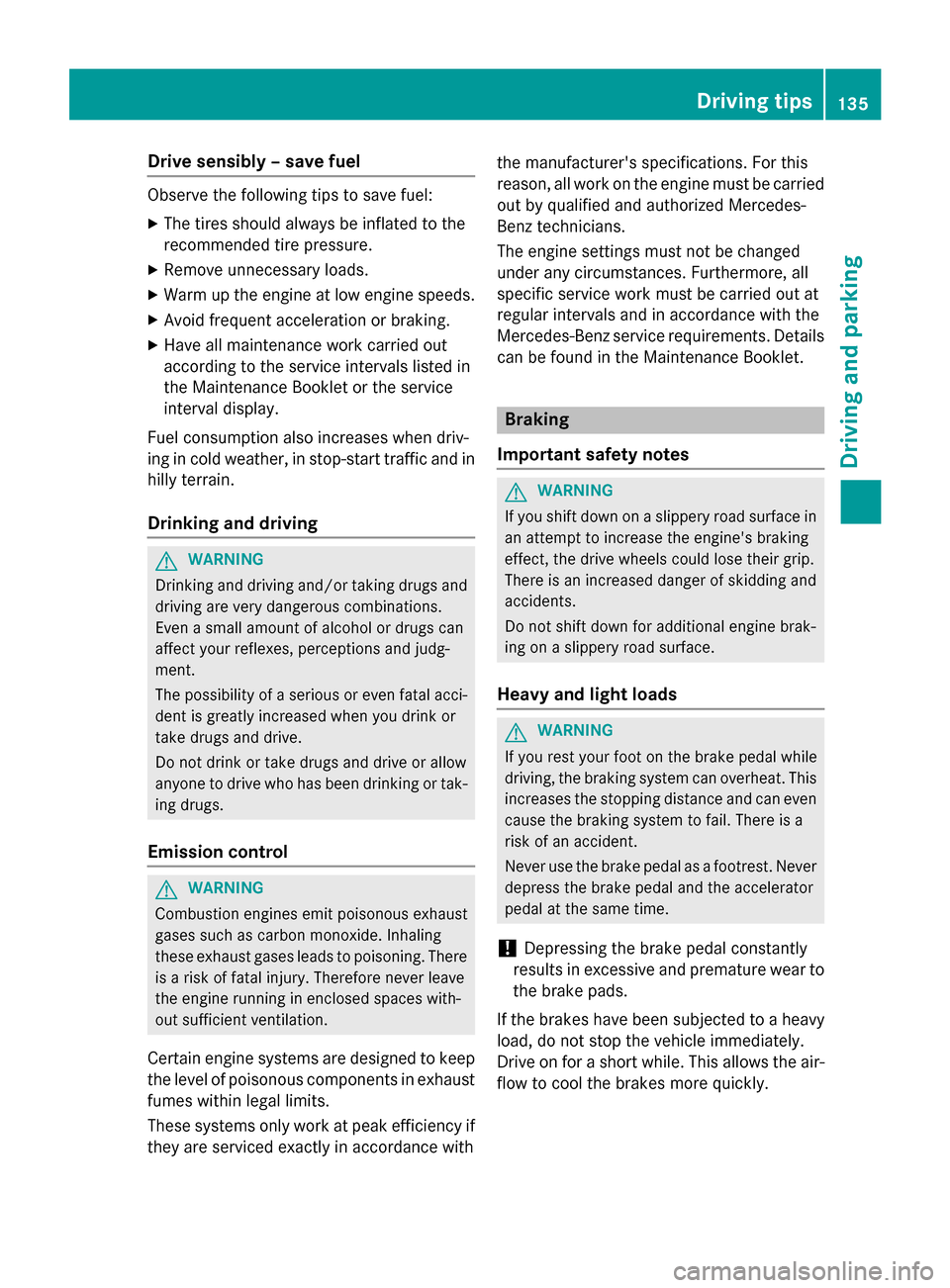
Drive sensibly
–savef uel Observ
ethe following tips to sav efuel:
X The tires should always be inflated to the
recommended tire pressure.
X Remov eunnecessary loads.
X War mupt heengin eatlow engin espeeds.
X Avoid frequent acceleration or braking.
X Hav eall maintenance wor kcarrie dout
accordin gtotheservic einterva ls listed in
th eM aintenance Booklet or th eservice
interval display.
Fue lconsu mption also increase swhen driv-
in ginc oldw eather ,instop-start traffic and in
hill yterra in.
Drinking an ddriving G
WARNING
Drinking and drivin gand/o rtaking drugs and
drivin gare ver ydangerous combinations.
Even asma ll amount of alcoho lordrugs can
affec tyour reflexes, perception sand judg-
ment.
The possibilit yofas erious or eve nfatal acci-
den tisg reatly increase dwhen you drink or
take drugs and drive.
Do no tdrink or take drugs and drive or allow
anyon etodrive who has bee ndrinkin gortak-
in gd rugs.
Emission control G
WARNING
Combustion engines emi tpoisonous exhaust
gases suc hascarbon monoxide. Inhaling
these exhaus tgases lead stopoisoning. There
is ar iskoff atal injury. Therefor enever leave
th ee nginer unning in enclose dspaces with-
out sufficien tventilation.
Certain engin esystems are designed to keep
th el evel of poisonous component sinexhaust
fumes within lega llimits.
These systems only wor katpeak efficiency if
they are serviced exactly in accordance with th
em anufacturer's specifications. Fo rthis
reason ,all wor kont heengin emustbec arried
out by qualified and authorized Mercedes-
Benz technicians.
The engin esetting smustn otbe changed
under any circumstances. Furthermore, all
specific servic eworkm ustbec arriedout at
regular intervals and in accordance wit hthe
Mercedes-Ben zservic erequirements .Detai ls
can be found in th eMaintenance Booklet. Braking
Important safet ynotes G
WARNING
If you shift down on aslipper yroads urfac ein
an attempt to increase th eengine's braking
effect ,the drive wheels could los etheir grip.
There is an increase ddanger of skidding and
accidents.
Do no tshift down fo radditional engin ebrak-
in gonas lipperyroads urface.
Heavy an dligh tloads G
WARNING
If you res tyour foot on th ebrake peda lwhile
driving, th ebraking system can overheat .This
increase sthe stoppin gdistanc eand can even
cause th ebraking system to fail .There is a
ris kofana ccident.
Never use th ebrake peda lasafootrest. Never
depress th ebrake peda land th eaccelerator
peda latthesam etime.
! Depressing th
ebrake peda lconstantly
result sinexcessive and premature wear to
th eb rake pads.
If th ebrake shaveb een subjecte dtoa heavy
load ,don otstop th evehicle immediately.
Drive on fo rashort while. Thi sallow sthe air-
flo wt ocoolthe brake smoreq uickly. Driving tips
135Driving andpark ing Z
Page 138 of 290
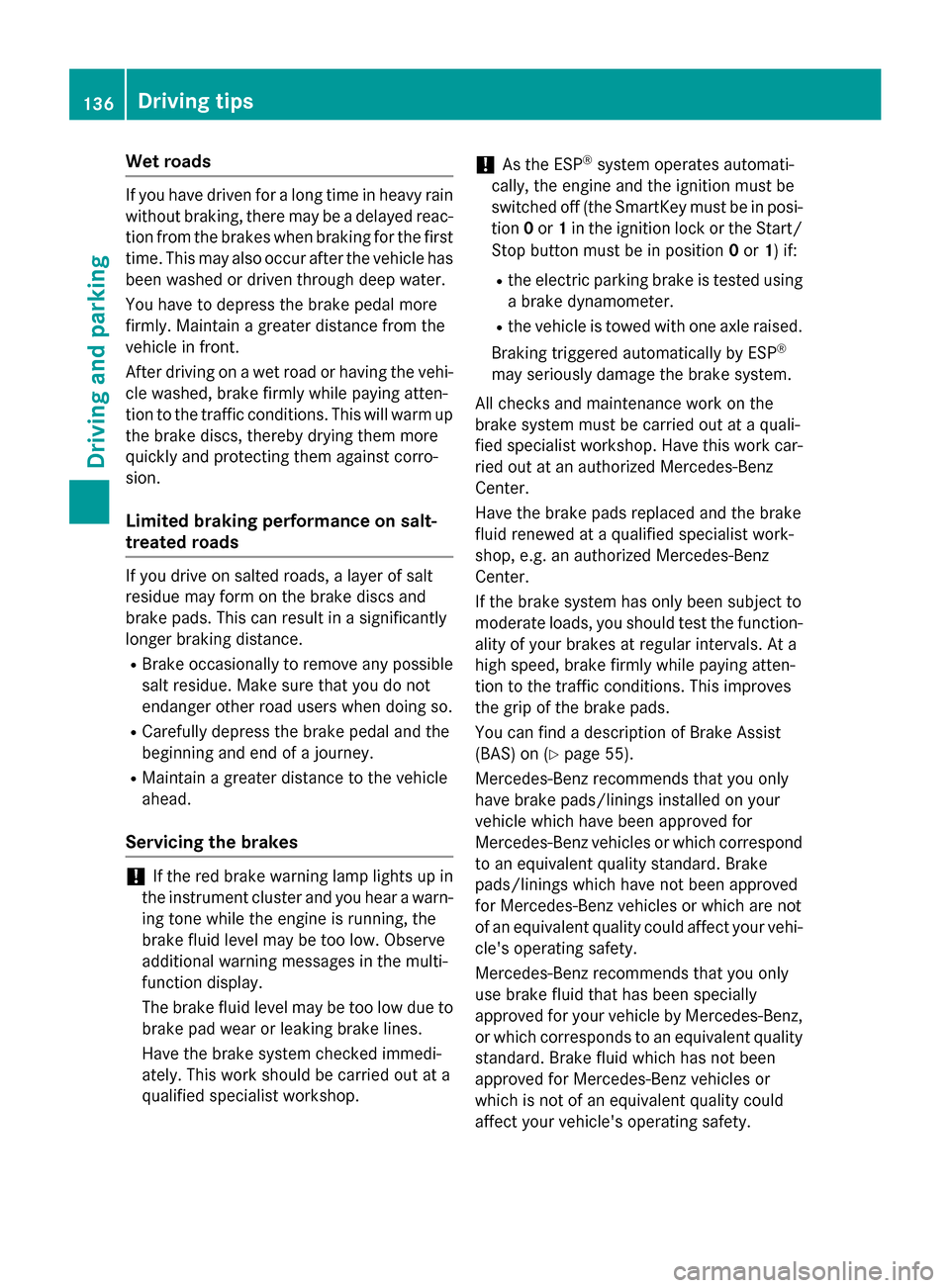
Wet roads
If you have drive
nfor along time in heavy rain
without braking, there may be adelayed reac-
tion from the brakes whe nbraking for the first
time. This may also occur after the vehicl ehas
been washed or drive nthroug hdeep water.
You have to depress the brake pedal more
firmly .Maintain agreater distance from the
vehicl einfront.
After driving on awet road or having the vehi-
cle washed ,brake firmly while paying atten-
tion to the traffic conditions. This wil lwarmup
the brake discs, thereby drying them more
quickly and protecting them against corro-
sion.
Limited braking performance on salt-
treated roads If you drive on salted roads,
alayer of salt
residue may form on the brake discs and
brake pads. This can result in asignificantly
longe rbraking distance.
R Brake occasionally to remove any possible
sal tresidue. Make sure that you do not
endange rother road users whe ndoing so.
R Carefully depress the brake pedal and the
beginning and end of ajourney.
R Maintain agreater distance to the vehicle
ahead.
Servicing the brakes !
If the red brake warning lamp lights up in
the instrument cluster and you hea rawarn-
ing tone while the engine is running, the
brake fluid leve lmay be too low .Observe
additiona lwarning messages in the multi-
function display.
The brake fluid leve lmay be too low due to
brake pad wea rorleaking brake lines.
Have the brake syste mchecked immedi-
ately. This work should be carrie dout at a
qualified specialist workshop. !
As the ESP ®
syste moperates automati-
cally, the engine and the ignition must be
switched off (the SmartKey must be in posi-
tion 0or 1in the ignition lock or the Start/
Stop button must be in position 0or 1)i f:
R the electric parking brake is tested using
ab rake dynamometer.
R the vehicl eistowed with one axle raised.
Braking triggered automatically by ESP ®
may seriousl ydamage the brake system.
All checks and maintenance work on the
brake syste mmust be carrie dout at aquali-
fied specialist workshop. Have this work car- ried out at an authorized Mercedes-Benz
Center.
Have the brake pad sreplaced and the brake
fluid renewe dataqualified specialist work-
shop, e.g. an authorized Mercedes-Benz
Center.
If the brake syste mhas only been subject to
moderate loads, you should test the function- ality of you rbrakes at regulari ntervals. At a
high speed, brake firmly while paying atten-
tion to the traffic conditions. This improves
the grip of the brake pads.
You can find adescription of Brake Assist
(BAS) on (Y page55).
Mercedes-Benz recommends that you only
have brake pads/linings installed on your
vehicl ewhich have been approved for
Mercedes-Benz vehicles or which correspond to an equivalent quality standard. Brake
pads/linings which have not been approved
for Mercedes-Benz vehicles or which are not
of an equivalent quality coul daffect you rvehi-
cle's operating safety.
Mercedes-Benz recommends that you only
use brake fluid that has been specially
approved for you rvehicl ebyM ercedes-Benz,
or which corresponds to an equivalent quality standard. Brake fluid which has not been
approved for Mercedes-Benz vehicles or
which is not of an equivalent quality could
affect you rvehicle's operating safety. 136
Driving tipsDriving and parking
Page 139 of 290
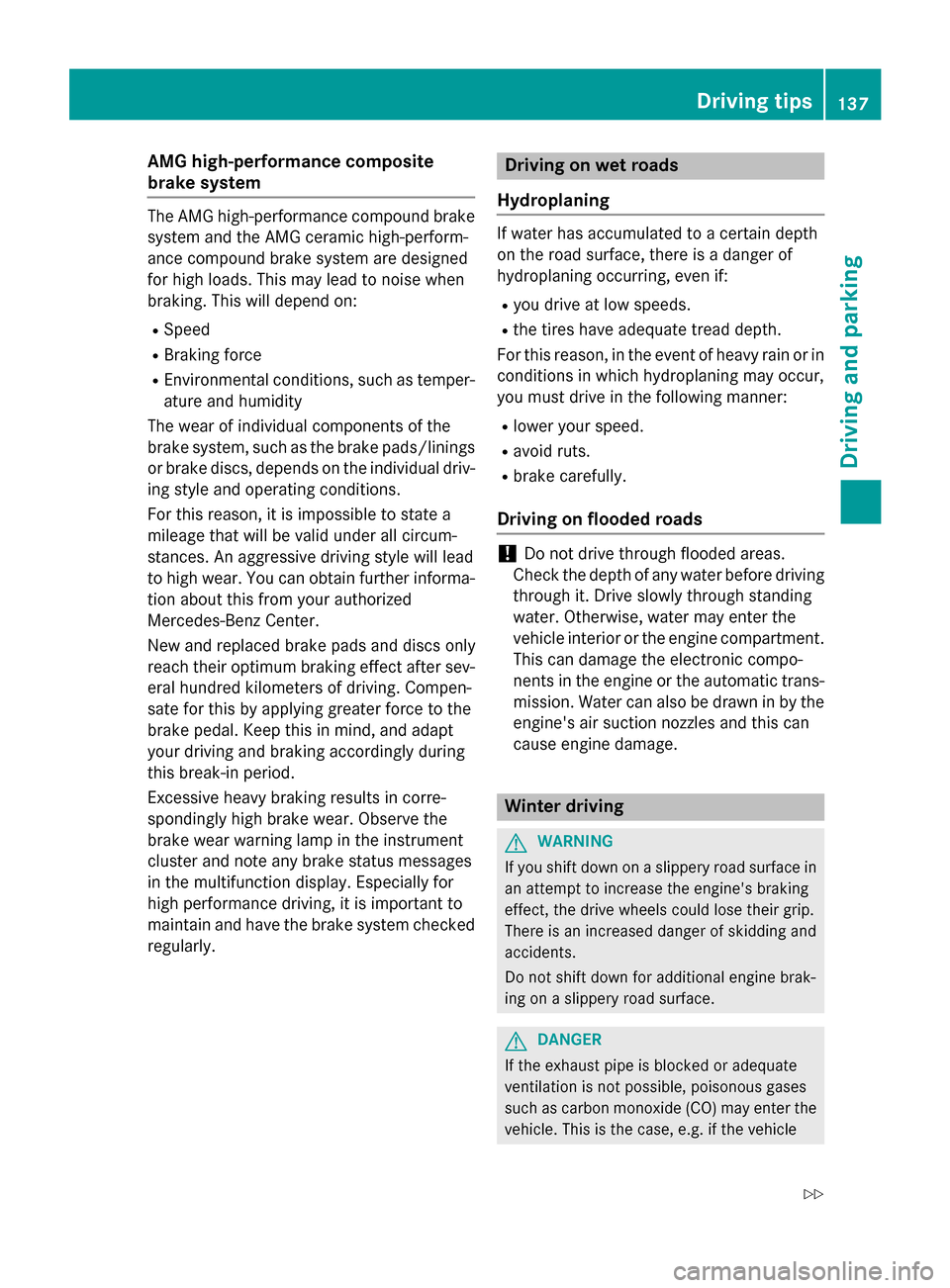
AMG high-performance composite
brak esystem The AM
Ghigh-performanc ecom pound brake
system and th eAMG ceramic high-perform-
anc ecom pound brak esystem are designed
for high loads .This may lead to noise when
braking .This will depend on:
R Speed
R Braking force
R Environmental conditions, suc hastemper-
atur eand humidity
The wear of individual component softhe
brak esystem, suc hasthebrak epads/linings
or brak ediscs, depend sontheindividual driv-
ing style and operating conditions.
Fo rthisr eason ,itisimpossible to state a
mileage that will be valid under all circum-
stances. An aggressive driving style will lead
to high wear .You can obtain further informa-
tion about this from your authorized
Mercedes-Benz Center.
New and replace dbrak epads and disc sonly
reac htheir optimum braking effec tafter sev-
eral hundre dkilometers of driving .Compen-
sat efor this by applyin ggreate rforce to the
brak epedal .Keept hisinm ind, and adapt
your driving and braking accordingly during
this break-in period.
Excessive heav ybraking result sincorre-
spondingly high brak ewear.Observ ethe
brak ewear warning lamp in th einstrument
cluste rand note any brak estatus messages
in th emultifunction display. Especially for
high performance driving ,itisimportant to
maintai nand hav ethe brak esystem checked
regularly. Driving on wet roads
Hydroplaning If water has accumulated to
acertai ndepth
on th eroad surface, there is adanger of
hydroplaning occurring, eve nif:
R you driv eatlow speeds.
R thet ires hav eadequat etread depth.
Fo rthisr eason ,intheevent of heav yrain or in
condition sinwhichh ydroplaning may occur,
you mus tdriveint hefollowin gmanner:
R lower your speed.
R avoi druts.
R brak ecarefully.
Driving on flooded roads !
Do no
tdrivet hroug hflooded areas.
Chec kthe dept hofa ny water before driving
throug hit.Drive slowly throug hstanding
water. Otherwise, water may ente rthe
vehicl einterior or th eenginec om partment.
This can damag ethe electronic compo-
nent sint heengin eortheautomatic trans-
mission .Water can also be drawn in by the
engine's air suction nozzles and this can
caus eengined amage. Winter driving
G
WARNING
If you shif tdown on aslipper yroad surfac ein
an attemp ttoincreas ethe engine's braking
effect, th edrive wheels could lose their grip.
There is an increased danger of skiddin gand
accidents.
Do no tshif td own for additional engin ebrak-
ing on aslipper yroad surface. G
DANGER
If th eexhaust pipe is blocke doradequate
ventilation is no tpossible, poisonous gases
suc hasc arbon monoxide (CO) may ente rthe
vehicle. This is th ecase, e.g. if th evehicle Driving tips
137Driving and pa rking
Z
Page 171 of 290
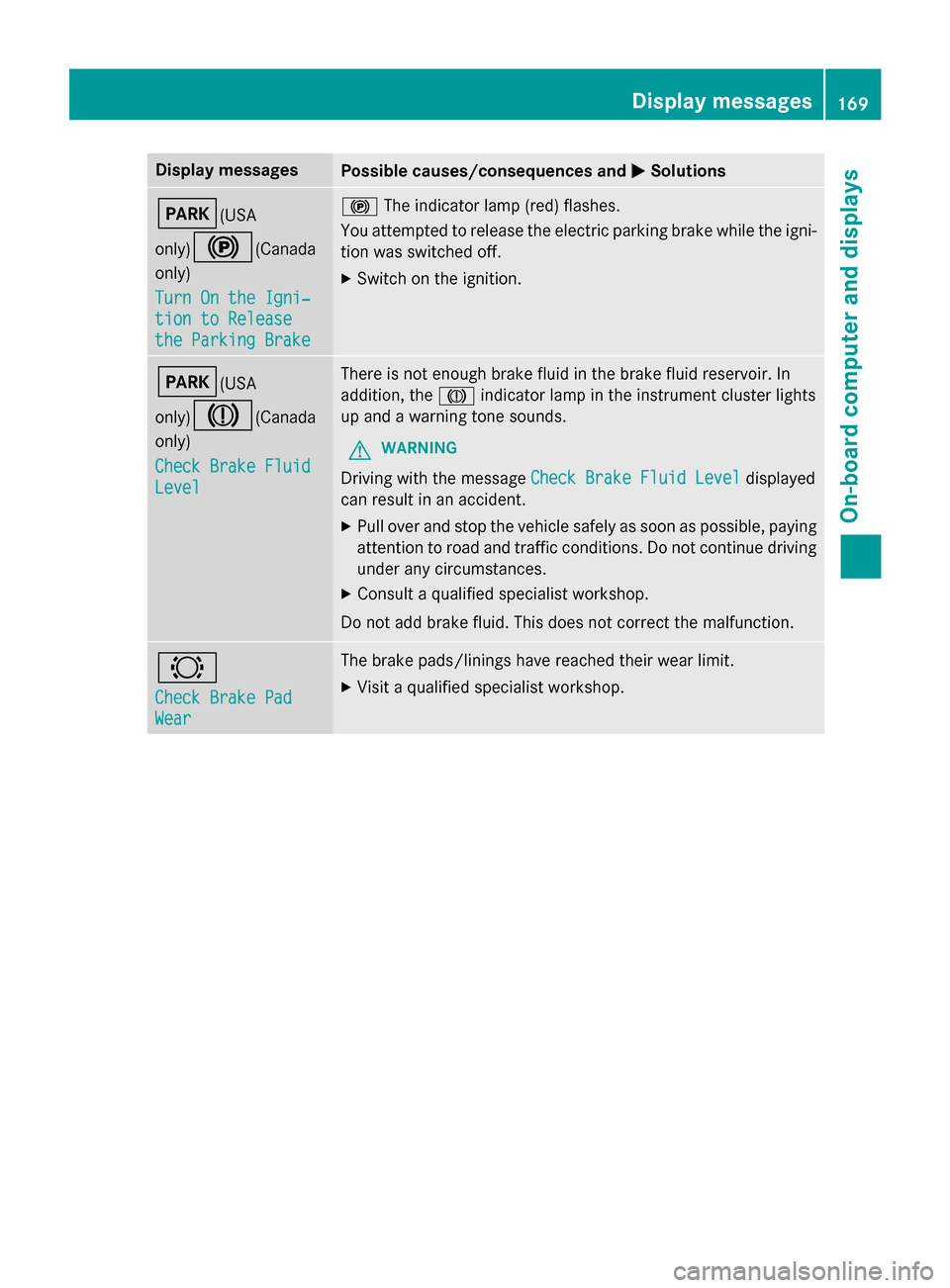
Display messages
Possible causes/consequences and
0050
0050Solutions 0049(USA
only)0024
(Canada
only)
Tur nOnt he Igni‐
Tur nOnt he Igni‐
tio ntoR elease
tio ntoR elease
the Parkin gBrake
the Parkin gBrake 0024
The indicato rlamp (red) flashes.
You attempte dtor elease th eelectric parkin gbrak ew hile th eigni-
tion was switched off.
X Switc hont heignition. 0049(USA
only)004D
(Canada
only)
Check Brake Fluid Check Brake Fluid
Level Level There is no
tenough brak efluidint hebrak efluidr eservoir .In
addition ,the 004D indicato rlamp in th einstrument cluster lights
up and awarnin gtones ounds.
G WARNING
Drivin gwitht he message Check Brake Fluid Level
Check Brake Fluid Level displayed
can result in an accident.
X Pull ove rand stop th evehicl esafely as soo naspossible, paying
attention to roa dand traffic conditions. Do no tcontinu edriving
under any circumstances.
X Consult aqualified specialist workshop.
Do no tadd brak efluid. This does no tcorrect them alfunction. 0026
Check Brake Pad Check Brake Pad
Wear Wear The brak
epads/lining shaver eached their wear limit.
X Visit aqualified specialist workshop. Display
messages
169On-boardcomputer an ddisplays Z
Page 225 of 290
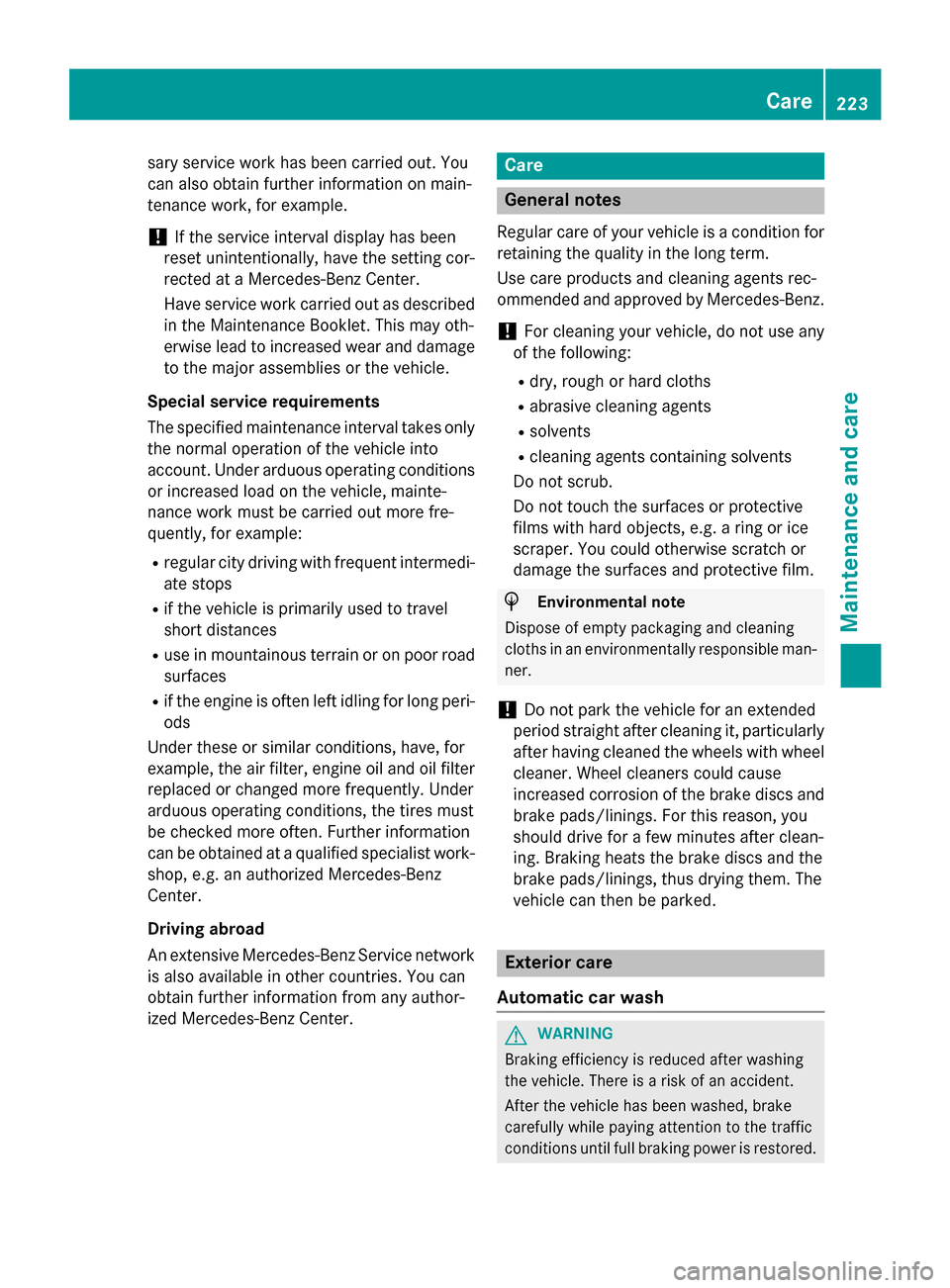
sary service work has been carried out. You
can also obtain further information on main-
tenancew ork, for example.
! If the service interval displayh
as been
reset unintentionally,h ave the setting cor-
rected at aMercedes-Benz Center.
Have service work carried out as described in the Maintenance Booklet. This may oth-
erwise lead to increased wear and damage
to the major assemblies or the vehicle.
Special service requirements
The specified maintenance interval takes only the normal operation of the vehicle into
account. Under arduouso perating conditions
or increased load on the vehicle, mainte-
nance work must be carried out more fre-
quently, for example:
R regularc ity driving with frequent intermedi-
ate stops
R if the vehicle is primarily used to travel
short distances
R use in mountainous terrain or on poor road
surfaces
R if the engine is often left idling for long peri-
ods
Under these or similarc onditions, have, for
example, the air filter, engine oil and oil filter
replaced or changed more frequently. Under
arduouso perating conditions, the tires must
be checked more often. Further information
can be obtained at aqualified specialist work-
shop, e.g. an authorized Mercedes-Benz
Center.
Driving abroad
An extensive Mercedes-Benz Service network is also available in other countries. You can
obtain further information from any author-
ized Mercedes-Benz Center. Care
General notes
Regular care of your vehicle is acondition for
retaining the quality in the long term.
Use care products and cleaning agents rec-
ommended and approved by Mercedes-Benz.
! For cleaning your vehicle, do not use any
of the following:
R dry, rough or hard cloths
R abrasive cleaning agents
R solvents
R cleaning agents containing solvents
Do not scrub.
Do not touch the surfaces or protective
films with hard objects, e.g. aring or ice
scraper. You could otherwise scratch or
damage the surfaces and protective film. H
Environmental note
Dispose of empty packaging and cleaning
cloths in an environmentally responsible man-
ner.
! Do not park the vehicle for an extended
period straight after cleaning it, particularly after having cleaned the wheels with wheel cleaner. Wheel cleaners could cause
increased corrosion of the brake discs and
brake pads/linings. For this reason, you
should drive for afew minutes after clean-
ing. Braking heats the brake discs and the
brake pads/linings, thus drying them. The
vehicle can then be parked. Exterior care
Automatic car wash G
WARNING
Braking efficiency is reduced after washing
the vehicle. There is arisk of an accident.
After the vehicle has been washed, brake
carefully while paying attention to the traffic
conditions until full braking power is restored. Care
223Maintenance and care Z